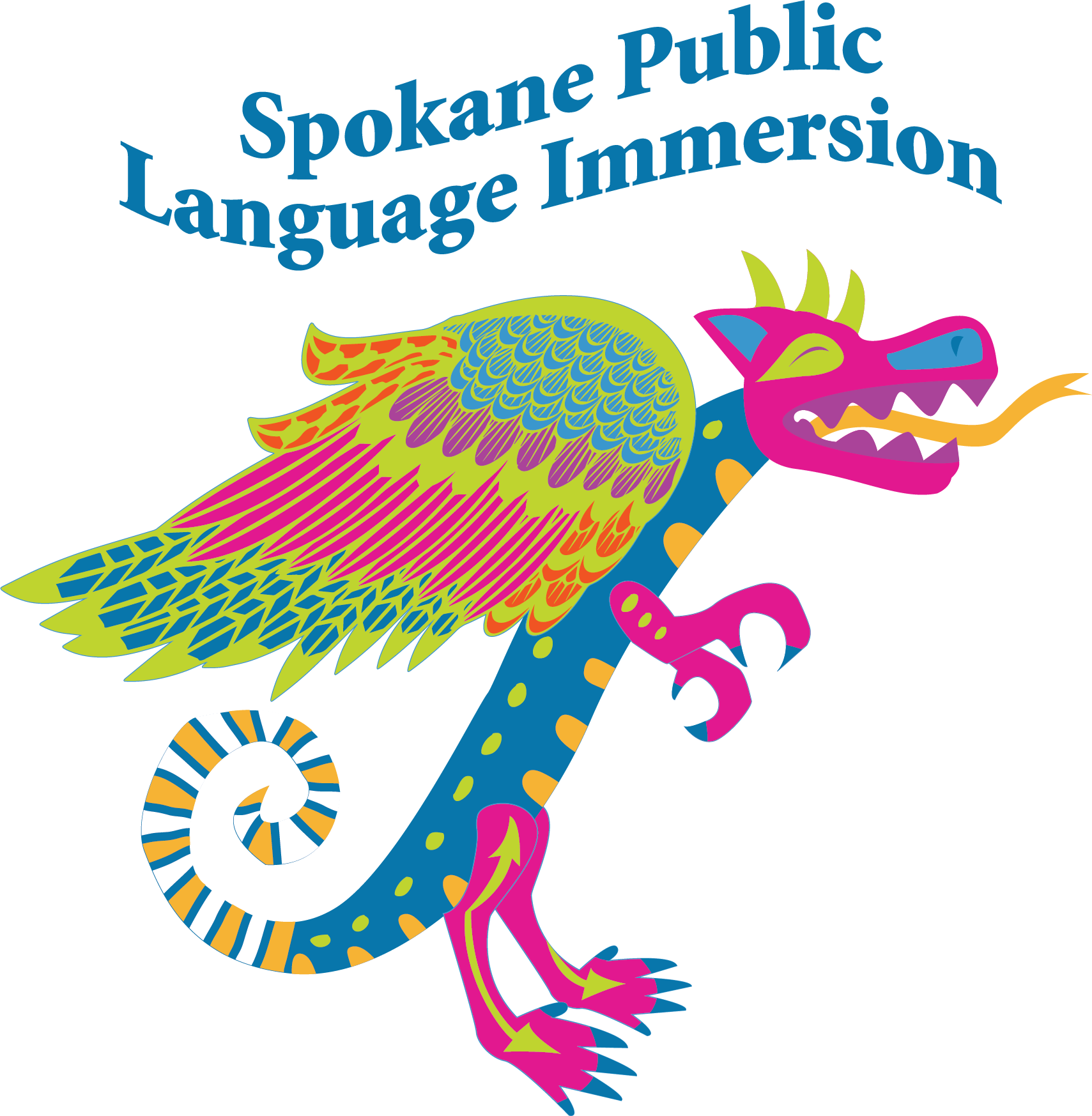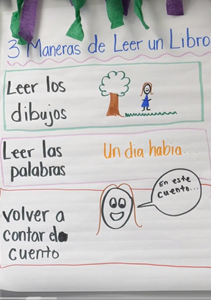What is immersion?
Language Immersion is language instruction in which typical learning activities and experiences are conducted in the minority language. The new language is the medium as well as the object of instruction. Immersion programs are centered around subject area instruction in the new language that occurs for at least 50% of the day.
Immersion classes typically follow the same curricula and often use the same translated materials as non-immersion schools in the district.
Immersion, both one-way and two-way, is an approach to dual language education and second language instruction (and sometimes third or fourth) in which typical core content learning experiences are conducted in the second language. The ultimate goal of the language immersion classroom is language acquisition through content.
In the early grades, teachers know that students may not fully understand what they are saying in the target language. Therefor they use body language, visuals, realia, exaggerated facial expressions, expressive intonation, etc. to communicate meaning to their students.
Our specific program is a Spanish immersion program that currently operates within the 50/50 framework; students spend half of their time in Spanish and half of their time in English. Students learn all content areas in both languages with the ultimate goal being language acquisition.
Why immersion?
According to the Center for Advanced Research on Language Acquisition (CARLA) at the University of Minnesota, immersion programs are one of the best means for language acquisition. Students in immersion programs are expected to reach higher levels of language proficiency in both languages than their peers in other, more traditional, language classrooms.
Due to substantial research on language acquisition, there has been a shift away from teaching language in isolation to integrating language and content. The shift is based on the following principles:
- Language is acquired most efficiently when learned through meaningful social context.
- Stimulating and engaging content provides the necessary context for learning the communicative functions of a language different from their native language.
- Language acquisition, cognition, and social awareness are interconnected in young learners.
- The functional and formal characteristics of languages shift from one context to another. A system that integrates language and content provides multiple contexts in which students can use the target language.
Two-way immersion programs and dual language programs increase the cognitive, emotional, and social skills of language learners in both languages. They are also the most effective programs for supporting English Language Learners.
What are the effects of an immersion education?
Research consistently shows that students in immersion and dual language programs regularly meet or exceed academic expectations in the following areas:
- English language skills
- Second language skills
- Content areas
- Cultural sensitivity
Why Spanish?
Spanish is the second most commonly spoken language in the United States and the fourth most commonly spoken language in the world. It is the official language on four contents. Additionally, the LatinX community is the fastest growing population in the United States. Being biliterate and bilingual in Spanish presents unique opportunities both professionally and personally, locally and globally.
What is our model, its key components, and our goals?
Our program currently operates within the 50/50 framework; students spend half of their time in Spanish and half of their time in English, switching halfway through the day. We follow our grade-level content allocation plan, adapted from Karen Beeman's Teaching for Biliteracy framework, to determine the primary language in which each content area is taught. The language of each content changes depending on the grade level, with teachers doing intentional review in both classes. Our goal is to create students who are bilingual, biliterate, and bicultural.
How do I enroll?
Enrollment into the immersion program is done through an application and lottery. The time period to apply is between February 8th through March 8th for the upcoming school year. Applications are done through the online portal on the SPS website.
The lottery takes place in late February and families are notified at that time about the status of their application. Those not enrolled are placed on a waitlist should openings occur. The waitlist only lasts for one school year so those who did not get accepted may wish to reapply for the following year.
The district allows priority for siblings of currently enrolled students, but you still must apply for the younger siblings during the time period mentioned above. Students who live outside of district boundaries receive last priority and have very little chance of being accepted. There are usually twice as many applications as there are seats available.
From second grade on, the program will only accept students who already have some Spanish language skills.
Is the program open to all students?
Yes. Any family that values a multilingual, multicultural, and globally-focused education can and should enroll in the program. All students are eligible to participate though be aware that language processing delays can be more pronounced in immersion and dual language programs.
What role do parents play in the school?
We believe that students learn most effectively when parents and teachers work hand in hand. An authentic, open partnership between home and school is the best way to foster growth that is sustainable and meaningful. Parents can volunteer in the classroom, attend field trips as a chaperone, and attend after school events and workshops. Moreover, parents support learning that students do outside of school both at home and in the world at large.
To truly support a child’s learning in an immersion program, it is imperative that families are making a long-term commitment to immersion education. Parents can support by:
- Develop an understanding of immersion and dual language education.
- Provide experiences outside of school to develop English and Spanish language skills.
- Encourage the use of Spanish outside of school.
- Be sure your child attends school every day.
How can I help my child at home if I do not speak the second language?
There are many ways in which parents can support language acquisition at home even if they themselves do not speak the second language. Some examples include:
- Provide cultural experiences outside of school (attending concerts, read alouds at the library, going to restaurants and reading the menu, etc.)
- Watch videos on YouTube with songs and repeated practice.
- Use a language-learning app such as DuoLingo, Babel, etc.
- Learn the language with your child.
- Attend the annual Language Workshop put on by our program.
- Ask your child’s teacher for additional resources.
Are teachers native speakers?
All of our classroom teachers, both Spanish and English, are bilingual. This is a requirement in our hiring process. Teachers must have a Washington State elementary teaching certificate and be highly proficient in both languages of instruction. It is not required that our specialist teachers speak Spanish, with the exception of our science teacher.
What level of skill in the second language will students have by fifth grade?
The goal is for students to speak the language at a high level of proficiency by the end of fifth grade. They will also have strong reading, writing, and listening skills in order to master the core content areas. In alignment with the American Council on the Teaching of Foreign Languages (ACTFL) proficiency levels, by the end of fifth grade students in our program should be intermediate high in speaking and listening, intermediate low in reading, and advanced low in writing.
Will my child be behind in one or both languages?
At first, yes. Most research shows that in the early years of an immersion or dual language program, students will be behind in one or both languages. This is due to the unique cognitive load placed on students learning all contents simultaneously in two languages. However, research also shows that by fifth grade students meet or exceed their peers on district- and state-mandated assessments in all content areas.
Do elementary immersion classrooms use the same curriculum as monolingual, English-only classrooms in district?
Yes. Our Immersion classrooms will be held to the same content standards as other classrooms, learning the same science, math, social studies and reading lessons; however, they will be taught in the second language. Science is taught by a Spanish specialist. Specials (such as music, art, physical education, and library) will be taught in English. However, it is important to note that teaching in the second language is not the same as simply translating English materials into Spanish. Teachers intentionally craft their lessons, based on the English-only content standards, to enhance students translanguaging and metalinguistic skills.
Am I able to transfer my student into the program if we didn’t start in kindergarten?
We maintain a waitlist of families who would like to be a part of the program, even after the kindergarten year. We do not anticipate having many openings in first grade and beyond, but there are times when families move or opt to return to their neighborhood school. In first grade, we will take both English and Spanish speaking transfers, but starting in second grade we will only be able to accept students who have some Spanish background and who are able to pass our target language skills estimation. This is due to the fact that English-speakers will have missed too much essential Spanish instruction and will be well behind their peers.
Will transportation be provided for my child to and from school?
Yes. Transportation is provided using a hub model. This means you can choose your bus stop from among many throughout the city. Immersion students ride with Odyssey students (grades 4-8).
Is there a PTG I can join?
Yes. Visit our website for the PTG contact. They meet once per month at Libby at approximately 6 pm.
Is there age-appropriate after school programming for my child?
Throughout the year there will be different clubs and activities that students can participate in. These activities occur from 2:30 -3:30 PM. Parents need to be able to pick up students at 3:30 PM. Clubs usually occur one day a week for 6 weeks. For example, in the fall, immersion students are able to participate in cross country. Clubs vary from year-to-year and the grade levels that can participate.
There is Express before and after school care available to immersion families, though it is not Spanish speaking. This year it is available at Longfellow Elementary.
What if I start in the program then feel like it isn’t the best setting for my child?
We hope this does not happen, but we understand that families must make decisions that are best for them. Your child would return to their neighborhood school if there is space. If there is no space, the district will provide transportation to an appropriate school.


